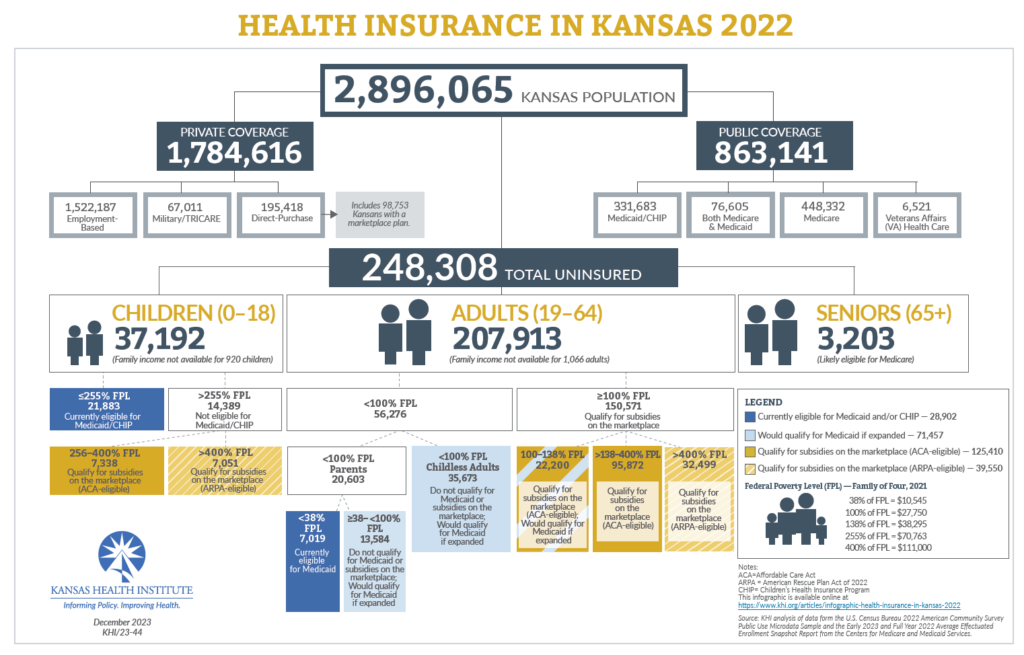Health insurance is considered essential to access high-quality health care and offers protection from excessive medical bills. Throughout the year, the Kansas Health Institute (KHI) provides detailed information about insurance coverage in Kansas to enrich ongoing discussion of health coverage options in Kansas and on the national level.
This infographic provides a high-level overview of insurance coverage for 2,896,065 Kansans in 2022.
Highlights include:
More than 1.7 million Kansans were covered by private insurance, including:
- 1.5 million by employment-based coverage,
- 67,011 by military or TRICARE insurance, and
- 195,418 by directly purchased insurance, including 98,753 on the Kansas marketplace created by the Affordable Care Act (ACA).
Another 863,141 were covered by public insurance, including:
- 448,332 by Medicare,
- 331,683 by Medicaid or the Children’s Health Insurance Program (CHIP),
- 76,605 by both Medicare and Medicaid, and
- 6,521 by Veterans Affairs health care.
And 248,308 Kansans were uninsured, including:
- 207,913 nonelderly adults, and
- 37,192 children.
Federal and state policies supported increased access to health insurance coverage during the COVID-19 pandemic. Medicaid and CHIP enrollees were allowed to remain enrolled without redetermination during the public health emergency. This infographic uses the latest-available data, which is from 2022; therefore, it reflects the continuous coverage period. Beginning in April 2023, in a process often referred to as unwinding, Kansas began to process all eligibility casework for KanCare that was not acted upon during the PHE.
Income eligibility limits to receive subsidies to purchase a plan on the health insurance marketplace are typically set as a percentage of the federal poverty level (FPL; $27,750 for a family of four in 2022). More households became eligible for subsidies through the American Rescue Plan Act of 2021 (ARPA), which made households above 400 percent FPL ($111,000 for a family of four in 2022) newly eligible for a marketplace subsidy in 2022. The amount they received depended on the benchmark plan premium and their household income. Households may not have received a subsidy if the premium for their benchmark silver plan was less than 8.5 percent of their annual income ─ the effective maximum income to receive a subsidy.
Two-thirds (164,960 or 66.4 percent) of uninsured Kansans in 2022 had household income that would have qualified them for subsidies to purchase health insurance on the Kansas marketplace. Among those who would have qualified, 125,410 (76.0 percent) would have qualified for subsidies to reduce monthly premiums under the original terms of the Affordable Care Act (ACA) and 39,550 (24.0 percent) would have newly qualified for subsidies under ARPA.
As of December 2023, Kansas is one of 10 states that have not implemented expanded Medicaid coverage to adults with household income up to 138 percent of FPL, as allowed by the ACA. In 2022, Medicaid expansion would have covered individual adults with annual household income up to $18,754 and adults in a four-person family with annual household income up to $38,295. If the state had expanded its program in 2022, 71,457 low-income, uninsured Kansas adults would have become newly eligible for Medicaid coverage. Another 28,902 low-income uninsured Kansas adults and children were likely already eligible for Medicaid or CHIP but were not enrolled.
For more information about the impact of Medicaid expansion on KanCare enrollment and expenditures, watch our website or sign up for our e-alerts to receive our upcoming Medicaid expansion estimate, which will be released in January 2024.
NOTE on data:
This infographic uses the latest-available data, which come from the 2022 American Community Survey Public Use Microdata Sample from the U.S. Census Bureau and the Early 2023 and Full Year 2022 Average Effectuated Enrollment Snapshot Report from the Centers for Medicare and Medicaid Services. The Kansas population presented is the non-institutionalized population in Kansas, which excludes those in settings such as correctional facilities, nursing homes, and psychiatric hospitals. Research has consistently shown that health insurance coverage surveys, including the American Community Survey (ACS), tend to underestimate the number of individuals enrolled in Medicaid. It is important to keep in mind that the ACS estimate of Medicaid enrollees may be lower than the number of Medicaid enrollees reported in state administrative data. Estimates of the number of Kansans eligible for Medicaid or qualifying for marketplace plans and subsidies are based on the Census Bureau definition of household units, which consist of all individuals currently residing in the sampled household, regardless of how members of the household are related. Actual experience may differ, as eligibility determinations for Medicaid and the health insurance marketplace include other considerations. The 2022 CHIP income limit used in this infographic is 255 percent of the 2022 FPL, which was increased from 255 percent of the 2008 FPL on July 1, 2022.
This Infographic is part of our Annual Insurance Update series.
